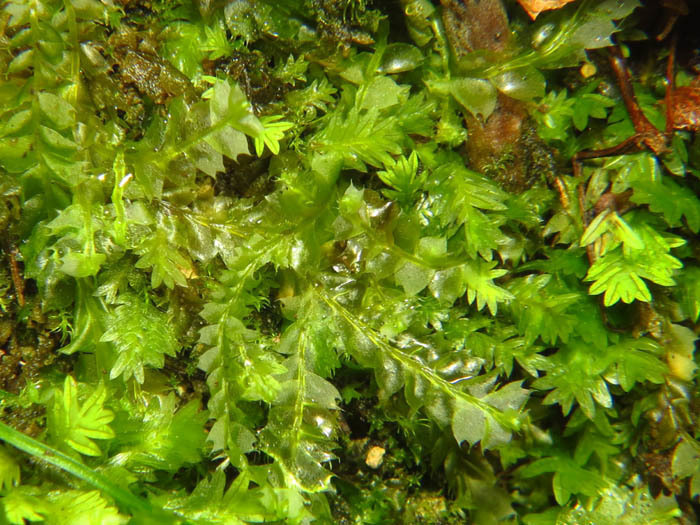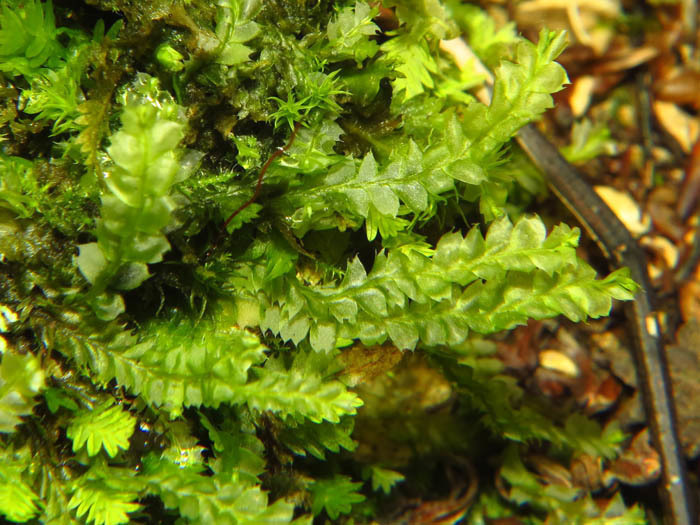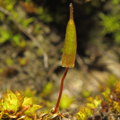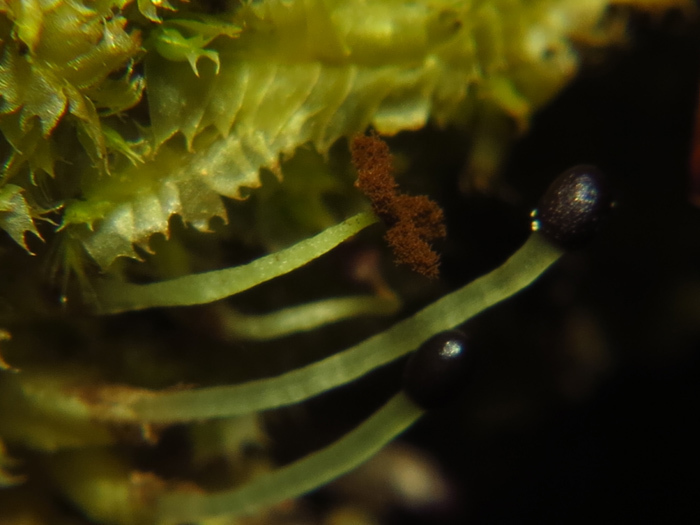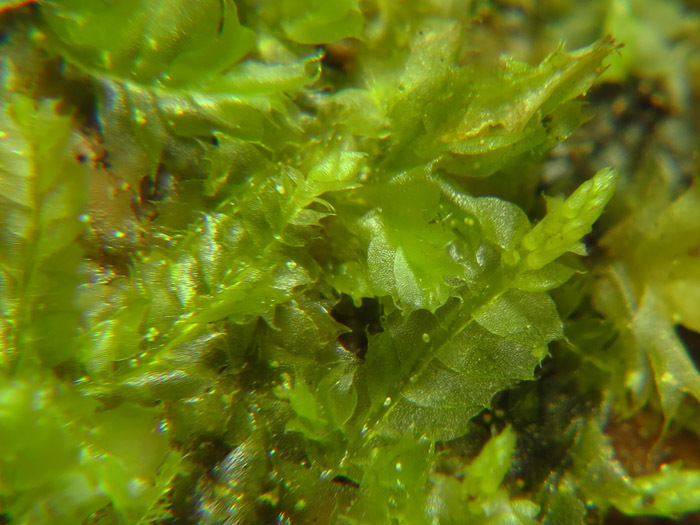Mieszają zdrowo w systematyce, można sie pochlastać tylko, co chwilę nowa wersja, nowe nazwy, nowe podziały... A żeby poprawnie wymówić Fuscocephaloziopsis loitlesbergeri, trzeba najpierw iść do logopedy ;-) Co Vani przeszkadzała Cephalozia???
Za Nordic Liverworts and Hornworts (Kell Damsholt):
Chiloscyphus coadunatus (Sw.) JJ.Engel et R.M.
-----------------------
Schust. Nova Hedw. 39: 413. Braunschweig. 1984.
Basionym: Jungermannia coadunata Sw. Fl. Ind. Occid.
Syn: Chiloscyphus cuspidatus (Nees) JJ.Engel et R.M. Schust. Nova Hedw. 39: 413. Braunschweig. 1984. Lophocolea bidentata (L.) Dumort. Recueil d'observ. Jung.: 17. Tournay. 1835. Jungermannia bidentata L. Spec, plant. ed. 1: 1132. Stockholm. 1753. Lophocolea bidentata var. cuspidata Nees Naturg. Eur. Leberm. 2: 327. 1836. Lophocolea cuspidata (Nees) Limpr. in Cohn. Krypt.-Fl. Schlesien 1: 303. Breslau. 1876.
Ecology. In pale yellowish- to whitish-green patches, mostly in areas with acidic substrates such as damp rock walls, stones and sandy banks of small streams and on decaying logs or stumps, often together with, e.g. Diplophyllum albicans, Lophozia ventricosa var. silvicola, Plagiochila asplenioides ssp. porelloides, Lepidozia reptans and Chiloscyphus profundus. More rarely occurring in places with some calcareous subsoil.
Chiloscyphus latifolius (Nees) J.J.Engel et R.M.
-----------------------
Schust. Nov. Hedw. 39: 418. Braunschweig. 1984.
Basionym: Lophocolea latifolia Nees. Naturg. Eur. Leberm. 2: 334. Berlin. 1836.
Syn: Lophocolea bidentata (L.) Dumort. Recueil d'observ. Jung.: 17. 1835, non Chiloscyphus bidentatus Steph. Hedwigia32: 320. 1893.
Ecology. In pale whitish-green patches among mosses and grasses on moist sandy soil or slopes in forests, rarely on banks, decaying logs and on moist rock walls. Also reported from rather dry places; in Denmark, C. latifolius has a more limited ecology, and is mainly found in wetlands, mires and marshes, frequent in Paludella fens, but it is unknown if the occurrence is similar in Sweden, Norway and Finland because of difficulties in identifying material lacking sex organs.
w kluczu:
2. Autoicous, often with perianths. Leaf lobes on average with 3-7 superimposed single cells at apex. Median leaf cells 25^40 μm wide. Plants often with 2-4
branches per cm stem; stem at most 3 cm long----------------C. coadunatus
2. Dioicous, rarely with perianths. Leaf lobes in average with 1-5 superimposed single cells at apex. Median leaf cells 22-34 μm wide. Plants often with less than 2 branches per cm stem; stem up to 6 cm long -----------C. latifolius
i uwagi do tych dwóch gatunków:
Differentiation. Chiloscyphus coadunatus is in the Nordic countries only confusable with the closely related C. latifolius. The autoicous inflorescence of C. coadunatus is usually easily demonstrated and distinguish it from the dioicous C. latifolius. When neither androecia nor gynoecia are developed, several vegetative characters can be used in separating the two taxa. The distinction between the two is less sharp in the vegetative characters so all the characters must be judged as a whole, as no single character is reliable. Chiloscyphus coadunatus differs from C. latifolius in 1) having somewhat larger cells, 2) having shorter shoots, 1-3 cm long, whereas (2-) 5-6 cm long in C. latifolius, 3) being more frequently branched and 4) having long-acuminate leaf lobes, at apex with 3-7 superimposed single cells, whereas leaf lobes in C. latifolius at apex have (1-) 2-4 (-5) superimposed single cells. Plants with well-developed male spikes, lacking perianths, may easily be confused for C. latifolius. Careful dissection will often reveal young gynoecia and the bisexuality of the plant can be concluded. Only when true male or female plants are found, they can safely be identified as C. latifolius. - C. coadunatus is a very variable species, among the many forms occurring in the Nordic countries differs fo. gracillima (Kaal.) comb. n. (Basionym: Lophocolea bidentata fo. gracillima Kaal. Nyt Mag. Naturv. 33: 473. 1893), strikingly from fo.
coadunatus by having median leaf cells 19-26 urn wide, almost as small as in C. fragrans and by having a limited occurrence in the southwestern part of Norway. Because of the small cells, that taxon was earlier referred to C. fragrans (syn.: Lophocolea fragrans (Morris et De Not.) Gottsche et al. fo. gracillima (Kaal.) Mull.Frib. Rabenh. Krypt-Fl. Deutschl. ed. 2. 6(1): 815. Leipzig. 1911), but it differs from that species in having the leaves divided 0.3-
0.5 of the length and in having acute leaf lobes at apex with 2-6 superimposed cells.
===========================================================================
A poczciwa Lophocolea heterophylla:
Chiloscyphus profundus (Nees) JJ.Engel et R.M.
Schust. Nov. Hedw. 39: 418. Braunschweig. 1984.
Basionym: Lophocolea profunda Nees, Naturg. Eur. Leberm. 2: 346. Berlin. 1836.
Syn: Lophocolea heterophylla (Schrad.)Dumort. Recueil d'observ. Jung.: 17. Tournay. 1835 non Chiloscyphus heterophyllus Steph. Spec. hep. 6: 308. Geneva. 1922. Jungermannia heterophylla Schrad. Joum, für die Bot. Jahrg. 1801. 5(1): 66.1803. Lophocolea mm« Lindb. Meddl. Soc. Faun. Flor. Fenn. 5: 13. 1880.
==============================================================
Ale Schumacker i Vana w "Liverworts and Hornworts" nie dzielą na dwa osobne gatunki i nawet zaznaczają że są one trudne do rozdzielenia:
Chiloscyphus coadunatus (Sw.) J.J. Engel et R.M. Schust. var. coadunatus = Jungermannia coadunata Sw., Chiloscyphus cuspidatus (Nees) J.J. Engel et R.M. Schust., Lophocolea alata (Nees) Schiffn., L. bidentata L. var. ciliata Vel. and var. cuspidata Nees, L. cuspidala (Nees) Limpr., L. hookeriana Nees, L. lateralis Dumort.
Chiloscyphus coadunatus (Sw.) J.J. Engel et R.M. Schust. var. rivularis (Raddi) Schumacker et Vana comb. nov. = Jungermannia bidentata L. var. rivularis Raddi 1818, Jungermaniograph. Etrusca: 26., Chiloscyphus latifolius (Nees) J.J. Engel et R.M. Schust., Jungermannia bidentata L., Lophocolea bidentata (L.) Dumort., L. bidentata (L.) Dumort. var. rivularis (Raddi) Warnst, L. latifolia Nees, L. rivularis (Raddi) Sde.-Lac.
i klucz:
Leaf cells 25-50 μm G coadunatus {= L. bidentata)
Note. Two varieties (separate species for some authors) are distinguished,
but they are often difficult to separate.
- Stem hardly branched; leaf lobes longly apiculate; autoicous; perianths common var. coadunatus (= L. cuspidata)
- Stem slightly branched; leaf lobes shortly apiculate; dioicous; perianths rare var. rivularis (= L. bidentata)
=======================================
Ale sa i inne źródła, które ignorują to zamieszanie ;-)


